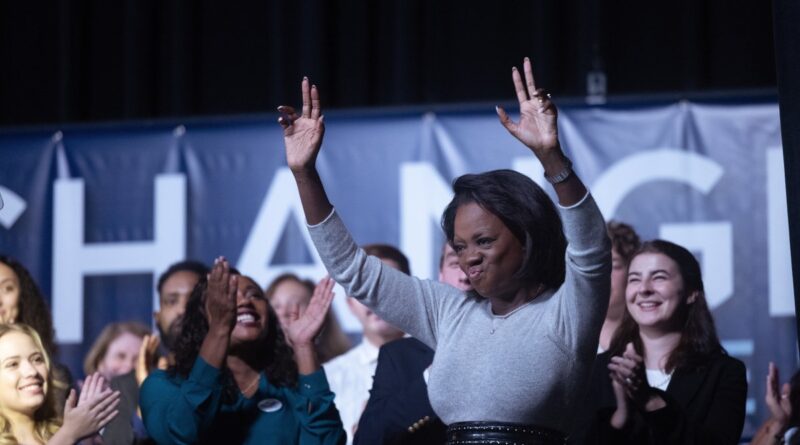Underwhelming political drama fails to do justice to its subjects
Showtime’s The First Lady sounds great on paper. Viola Davis, Michelle Pfeiffer, and Gillian Anderson playing three influential first ladies? That seems like the perfect recipe for prestige TV. Unfortunately, while all three actors’ performances are excellent, they can’t save a jumbled series that never fully comes together.
In calling itself The First Lady instead of the original production title, First Ladies, this miniseries positions itself more as an examination of the title of “first lady” than as a character study of any first lady in particular. We see how three different women — Michelle Obama (Davis), Betty Ford (Pfeiffer), and Eleanor Roosevelt (Gillian Anderson) — inhabited the role and influenced American politics. But in splitting our time between the three of them, we lose the depth of their individual stories. That’s a real shame, and the show’s biggest failure.
Getting to know the first ladies

Gillian Anderson as Eleanor Roosevelt
Credit: Daniel McFadden / Showtime
The First Lady tracks the personal and political lives of Michelle, Betty, and Eleanor from just before they enter the White House to what happens after they leave. We also see flashbacks to their youths, including their relationships with husbands Barack (O-T Fagbenle), Gerald (Aaron Eckhart), and Franklin (Kiefer Sutherland).
In splitting our time between the three first ladies, we lose the depth of their individual stories.
Each woman has their own worries about becoming first lady, as well as their own ideas of what they can accomplish. Michelle is keenly aware of the pressure on her as the first Black first lady, and she’s committed to continue her work making healthcare accessible to underprivileged communities. Betty would rather not be the first lady — her husband became president after Nixon’s resignation — but ends up a firm champion for the Equal Rights Amendment. Eleanor is ready to take an active role in Franklin’s administration, but, like the other subjects of this series, is often sidelined by her husband’s team.
This underestimation across all three storylines leads to Big Inspirational Moments in which the people who didn’t believe in the first ladies admit they were wrong. But these moments are undermined by the fact that the show itself seems to underestimate its leads. Smashing their lives together with very little connective tissue suggests The First Lady didn’t believe these women’s stories could stand on their own. Trust me, they can!
The First Lady feels more like a history lesson than a television show

Michelle Pfeiffer as Betty Ford
Credit: Murray Close / Showtime
What makes The First Lady even more of a frustrating watch is that it uses the characters of Michelle, Betty, and Eleanor less as focal points and more as lenses through which to observe American history.
Over the course of its 10 episodes, The First Lady speed-runs the Obama, Ford, and Roosevelt presidencies and shoehorns the first ladies in whenever they can. The Michelle Obama storyline suffers the most from this, leaping haphazardly from issues of healthcare, police brutality, and gun violence without ever fully digging its feet into any of them. Michelle mostly reacts to these topics in discussions with her family. We see far too little of her developing her own initiatives or working behind the scenes.
‘The First Lady’ uses the characters of Michelle, Betty, and Eleanor less as focal points and more as lenses through which to observe American history.
Because Michelle was in the White House for eight years, and Eleanor for 12, the time we spend with them rushes by at a breakneck pace. Years pass between episodes, and we’re left to fill in the blanks. Conversely, Betty was in the White House for two and a half years, so the show is able to take more time with her. I found her storyline to be the most interesting, partly because I knew the least about her stint as first lady, and partly because the slower pacing gave her third of the show more time to breathe.
Any juxtapositions between Michelle, Betty, and Eleanor are either incidental, like their husbands’ arrival in office, or clumsy. One episode awkwardly connects the Obama administration’s stance on gay marriage to the beginnings of Eleanor’s romantic relationship with journalist Lorena Hickok (Lily Rabe).
Despite the focus on big moments in American history, The First Lady is at its best when it shifts its attention to Michelle, Betty, and Eleanor’s personal lives. One of the show’s stronger episodes follows young versions of each first lady (played by Jayme Lawson, Kristine Froseth, and Eliza Scanlen) as they pursue their hopes and dreams (and also meet their future husbands). It’s an episode that gives us a better idea of who Michelle, Betty, and Eleanor are as people, not as historical figures. If only that energy had carried through the rest of the show.
The First Lady premieres April 17 at 9 p.m. ET on Showtime, with new episodes weekly.

